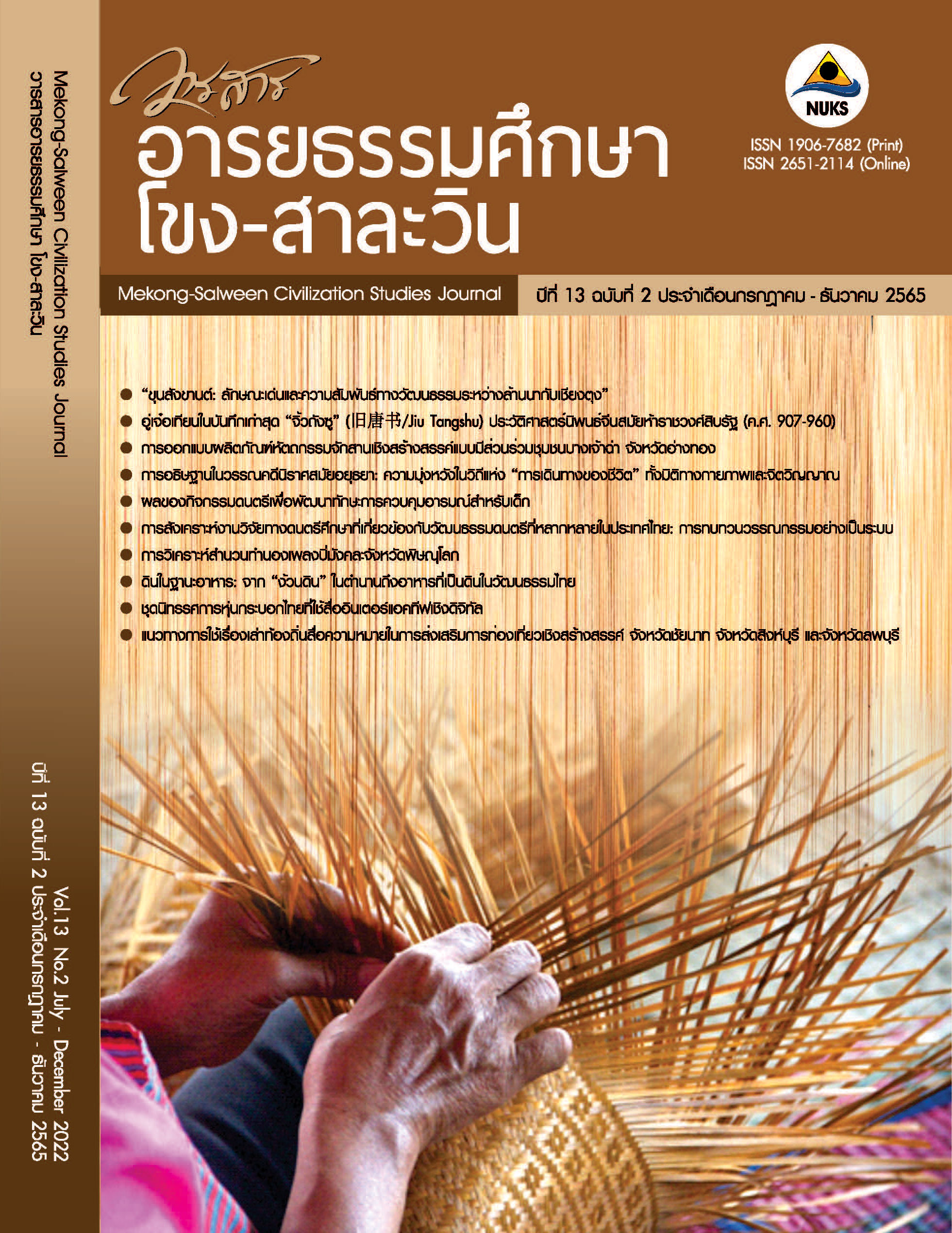Soil as Food: From the Myth of Nguan Din to Soil as Food in Thai Culture ดินในฐานะอาหาร: จาก “ง้วนดิน” ในตำนานถึงอาหารที่เป็นดินในวัฒนธรรมไทย
Main Article Content
Abstract
From the cultural point of view, some groups of primitive societies believed that they originated from the soil or the earth and regarded earth spirits as gods and ancestral spirits. When cooking, they brought clay to make a hearth in the kitchen. When doing important rituals, it must “awaken the earth” or tell the ghost of the earth. Even when someone died, he/she was buried back into the bosom of the land. In addition, “Soil” is considered to be the first food of human beings in the Buddhist legend, as appeared in “Nguan Din”, which is the soil burned by fire "Pralai-kalp" as appeared in the Aggañña Sutta and scriptures in the cosmology group in Thai society. This is why it is interesting to study how the traces of humans eating soil still remains in Thai culture. This article therefore aims to study soil as food both from legends and way of life by studying from documents, textbooks, and scriptures. The results of the study revealed that, in Thai society, there were rituals and beliefs about soil, both from traditional beliefs and new beliefs from Brahminism and Buddhism. It was also found that there were various tales and legends mentioning motif "Humans eat soil". In the real life, it was found that the soil was eaten as well and divided into 3 types of soil which are 1) soil with special characteristics, 2) soil with special properties, and 3) soil with special power. The mythological appearance of soil-eating humans is evidence of eating soil from primitive societies in the real world, reflecting 1) soil and the connection between man and nature; 2) soil and showing that man is one with nature, and 3) soil and the representation that humans are part of nature.
Downloads
Article Details

This work is licensed under a Creative Commons Attribution-NonCommercial-NoDerivatives 4.0 International License.
References
Arunsak, K. (2017). Dhipayapratima: Origins and Meanings 14 Dhipaya of fortune-abundance of Thailand and Asia. Nonthaburi: Museum Press.
Baanjomyut. (2000). Theory of Buddhist world evolution. Retrieved January 18, 2022, from https://www.baanjomyut.com/library_3/
Baothong, S. (2010) Beliefs about eating soil. Retrieved January 28, 2022, from https://sites.google.com/site/tuysaranya/
Boonpitak, S., et al. (2016). Culture Traditional and Local Knowledge of Farmer's Plant Local Rice in Muang and Sai Ngam Districts, Kamphaeng Phet Province. [Special issue]. The Golden Teak : Humanity and Sai Ngam Districts, Kamphaeng Phet Province. [Special issue]. The Golden Teak : Humanity and Social Science Journal (GTHJ.), 22, 94-103.
Chao Phraya Phra Klang (Hon). (1946). Rajadhiraj episode 15, extracted from the Raman Chronicle on Rajadhiraj. Retrieved January 29, 2022, from https://vajirayana.org/
Chinworasiriwat, N. (2020). The secret that soldiers must do before they travel far from home is to put soil on their heads. Retrieved January 29, 2022, from http://www.liekr.com/
Department of Cultural Promotion. (2012). Intangible Cultural Heritage: Nang Phokhawadee. Retrieved 29 January 2022, from http://ich.culture.go.th/index.php/th/ich/folk-literature/
Dhammapadattha. (2008). Pandivaga Vanna 8. The story about 500 monks. Retrieved February 2, 2022 from https://th.wikisource.org/wiki/
Fine Arts Department (1939). Chronicle Conference Region 72 The Legend of Suwan Khom Kham. Mrs. Wicharanawat and Phraya Wisetsupawat. Printed as a souvenir at the funeral of Mrs. Siew Kanchanasapt, her mother, on May 25, 1939 at Wat Makutkasatriyaram. Bangkok.
Flynt, W. (2004). Dixie's forgotten people: The South's poor whites. Bloomington: Indiana University Press. Harvey, G. E. (1925). History of Burma: From the Earliest Times to 10 March 1824. London: Frank Cass & Co. Ltd.
Harvey, G. E. (1925). History of Burma: From the Earliest Times to 10 March 1824. London: Frank Cass & Co. Ltd.
Jaifai, P. (2017). Book Review Ecology and Religion: Ecological Spirituality in Cross-Cultural Perspective. Panidhana : Journal of Philosophy and Religion,13(1), 183-187.
Kasempholkoon, A. (2012). The Maintenance of Identity of the “Chong” Ethnic Group: A Case Study from Song Nai BanRitual in Ban Thung Kai Dak, Amphoe Mueang, Trat Province. Journal of Thai Studies, 8(1),87-124.
Learning Center for Earth Science and Astronomy (LESA). (2010). Earth science and astronomy learning materials. Retrieved January 29, 2022, from http://www.pw.ac.th/emedia/media/science/lesa/index.html
Liao Seng, M. (2009). Revisiting the past of Isan people. Retrieved January 25, 2022, from https://changthaidotcom.wordpress.com/
Mitpraphan, W. (2012). Common Characteristics and Relationship between Literature and Locality of the legend of Pathom Kapp / Pathom Mun; the edition of Xishuangbanna Lanna and Isan. Journal of Humanities and Social Sciences Bansomdejchaopraya Rajabhat University, 9(1), 45-58.
Office of Information Technology, Sukhothai Thammathirat Open University. (2019). Phi Ta Haek.. Retrieved January 28, 2022, from https://library.stou.ac.th/odi/online/exhibition
Office of the Royal Society (2012). Din Thanan. Retrieved January 28, 2022, from http://legacy.orst.go.th/?knowledges
Patcharaphisuth, C. P., & Tansit, S. S. (2017). Eat soil as a snack. Retrieved January 28, 2022, from https://www.tnews.co.th/social/384065
Phayre, A. P. (1873). The History of Pegu: Journal of Asiatic Society of Bengal. N. P.: Oxford University.
Phichiansunthorn, C., & Jeeruangs, W. (2013). Handbook of Thai Traditional Pharmacy, Volume 4, Mineral Medicine. Bangkok: Amarin
Phrommathep, N. (2012). The Legend of Lanna Ghosts: Phi Pong Dong Dam. Retrieved January 28, 2022, from https://www.gotoknow.org/posts/150330
Sarikabutr, T. (1973) Buddhist scriptures. Bangkok : Sillapabannakhan.
Savanayon, N. (2006). The Encyclopedia of Thai Traditions - Folk Tradition Section, Volume 1 . Bangkok: Fine Arts Department.
Wiriyaburana, U., et al. (1968). The Royal textbook of Brahmachat: the most complete. Bangkok: Sor Thamphakdi's printing house.
Young, S. L. (2011). Craving earth : understanding pica : the urge to eat clay, starch, ice, and chalk. New York: Columbia University Press.


